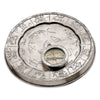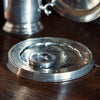Callisto Stellar Compass - 17.5 cm Diameter - Handcrafted in Italy - Pewter
The compass, one of the most fascinating of instruments, is thought to have originated from China over two thousand years ago. Cosi Tabellini have crafted a desk version, cradled within a solid pewter base and frame that sits upon a celestial plate, again, handcrafted from pewter, with accurate and elaborate engravings of constellations of the Northern hemisphere in the centre and the periods of the Zodiac calendar around the outside.
The observation of the stars and their position in the celestial sphere has fascinated humans since the beginning of recorded history. For this reason various types of instruments were made in order to make easier the identification of the constellation and their movements.
With the Stellar Compass it is possible to locate the position of the constellation of the Northern hemisphere according to the month in which the sky is observed. To do this it is necessary to have the inscription "MEDIA NOCTE" (on the compass) coincide with the zodiacal sector of the period of observation; then, turn the complete instrument until the compass needle is orientated towards the polestar "POLARIS" (North).
The celestial sphere will now correspond to the one represented on your instrument. For optimal results the stellar compass should be used at midnight. You will now find directly overhead (or zenith) the constellation which appears underneath the compass.
The theory that the Chinese invented the compass derives from the legend of the "south-pointing chariot", a machine in which the arm of a humanoid figure always pointed towards South. If we are to believe this, then the compass appeared as early as 2634 BC, the year in which the Emperor Huang-ti fought and won a battle against rebels making use of these chariots to guide his troops against the enemy through a thick fog. However, for the sceptics, or realists among us, the first real evidence shows that the Chinese used the compass during the Han Dynasty between the second Century BC and first Century AD.
These first compasses were made of lodestone, which is a type of naturally magnetic iron ore called magnetite, which when suspended turns freely, always resting in the same direction, aligning itself toward the magnetic poles. These first compasses were used to source precious stones, fortune telling, and deciding on the position of a house; all ancient forms of harmonising with the environment - an early form of Feng Shui. The first instance in which a compass seems to have been used to navigate is contained in a book entitled P'ing-chou-k'o-t'an which dates back to about the end of the eleventh Century, during the innovative Song Dynasty.
It has also been thought that the compass was invented by the Islamic world around the thirteenth Century, a theory supported by the fact that at that time they enjoyed unchallenged superiority in the scientific field and were highly skilled in the art of navigation, and it can be seen that around this time they were linking compasses to astronomy. Yet other scholars observe that the Arabs, Turks and Persians all called the navigational instrument "bossola", a word derived from Italian. This would support a European origin, and Scandinavian references date back to about 1250 AD, and elsewhere in Europe the late 12th Century. It seems with the onset of travel and exploration, the concept of navigation, and the use of a compass evolved and dispersed over the globe.
Whatever the origins, a compass always is fascinating to young and old, and makes a poignant gift, ideal for displaying, perhaps, on a desk or bookshelf, or maybe used as a paperweight. It is also a thoughtful and philosophical gift for a young person, symbolically given to aid their navigation through life itself.
Buying as a gift? Why not make it even more special with our engraving service?
Size: Diameter 17.5 cm
Weight: 410 g
Materials Used: Pewter
Ref: CT0096701
Designers: Enrico Cosi & Sergio Tabellini
100% Lead Free
All Cosi Tabellini Pewter is 100% lead-free, so it is totally food & drink safe, and is both EU and US FDA approved.
Packaging
Cosi Tabellini pieces come gift-boxed with a guarantee card and instructions on how to care for pewter.



